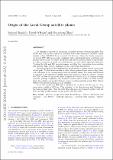Files in this item
Origin of the Local Group satellite planes
Item metadata
| dc.contributor.author | Banik, Indranil | |
| dc.contributor.author | O'Ryan, David | |
| dc.contributor.author | Zhao, Hongsheng | |
| dc.date.accessioned | 2018-04-16T08:30:16Z | |
| dc.date.available | 2018-04-16T08:30:16Z | |
| dc.date.issued | 2018-07-11 | |
| dc.identifier.citation | Banik , I , O'Ryan , D & Zhao , H 2018 , ' Origin of the Local Group satellite planes ' , Monthly Notices of the Royal Astronomical Society , vol. 477 , no. 4 , pp. 4768-4791 . https://doi.org/10.1093/mnras/sty919 | en |
| dc.identifier.issn | 0035-8711 | |
| dc.identifier.other | PURE: 252805899 | |
| dc.identifier.other | PURE UUID: 5152a586-b866-4959-bd5f-1ae86fbbeda0 | |
| dc.identifier.other | ORCID: /0000-0002-4123-7325/work/43646817 | |
| dc.identifier.other | WOS: 000435630100037 | |
| dc.identifier.other | Scopus: 85048776881 | |
| dc.identifier.uri | https://hdl.handle.net/10023/13135 | |
| dc.description | IB was supported by Science and Technology Facilities Council studentship 1506672. The work of DOR was enabled by Royal Astronomical Society undergraduate research bursary 6390/302/001. | en |
| dc.description.abstract | We attempt to understand the planes of satellite galaxies orbiting the Milky Way (MW) and M31 in the context of Modified Newtonian Dynamics (MOND), which implies a close MW-M31 flyby occurred ≈8 Gyr ago. Using the timing argument, we obtain MW-M31 trajectories consistent with cosmological initial conditions and present observations. We adjust the present M31 proper motion within its uncertainty in order to simulate a range of orbital geometries and closest approach distances. Treating the MW and M31 as point masses, we follow the trajectories of surrounding test particle disks, thereby mapping out the tidal debris distribution. Around each galaxy, the resulting tidal debris tends to cluster around a particular orbital pole. We find some models in which these preferred spin vectors align fairly well with those of the corresponding observed satellite planes. The radial distributions of material in the simulated satellite planes are similar to what we observe. Around the MW, our best-fitting model yields a significant fraction (0.22) of counter-rotating material, perhaps explaining why Sculptor counter-rotates within the MW satellite plane. In contrast, our model yields no counter-rotating material around M31. This is testable with proper motions of M31 satellites. In our best model, the MW disk is thickened by the flyby 7.65 Gyr ago to a root mean square height of 0.75 kpc. This is similar to the observed age and thickness of the Galactic thick disk. Thus, the MW thick disk may have formed together with the MW and M31 satellite planes during a past MW-M31 flyby. | |
| dc.format.extent | 24 | |
| dc.language.iso | eng | |
| dc.relation.ispartof | Monthly Notices of the Royal Astronomical Society | en |
| dc.rights | © 2018, the Author(s). This work has been made available online in accordance with the publisher’s policies. This is the author created, accepted version manuscript following peer review and may differ slightly from the final published version. The final published version of this work is available at https://doi.org/10.1093/mnras/sty919 | en |
| dc.subject | Methods: data analysis | en |
| dc.subject | Methods: numerical | en |
| dc.subject | Galaxy: disc | en |
| dc.subject | Galaxy: kinematics and dynamics | en |
| dc.subject | Galaxies: groups: individual: Local Group | en |
| dc.subject | Dark Matter | en |
| dc.subject | QB Astronomy | en |
| dc.subject | QC Physics | en |
| dc.subject | Astronomy and Astrophysics | en |
| dc.subject | NDAS | en |
| dc.subject.lcc | QB | en |
| dc.subject.lcc | QC | en |
| dc.title | Origin of the Local Group satellite planes | en |
| dc.type | Journal article | en |
| dc.description.version | Postprint | en |
| dc.contributor.institution | University of St Andrews. School of Physics and Astronomy | en |
| dc.identifier.doi | https://doi.org/10.1093/mnras/sty919 | |
| dc.description.status | Peer reviewed | en |
| dc.identifier.url | https://arxiv.org/abs/1802.00440 | en |
| dc.identifier.url | https://academic.oup.com/mnras/advance-article/doi/10.1093/mnras/sty919/4969697?guestAccessKey=bb8593b3-657d-45be-b2c3-9aa31bcc2b44 | en |
This item appears in the following Collection(s)
Items in the St Andrews Research Repository are protected by copyright, with all rights reserved, unless otherwise indicated.

